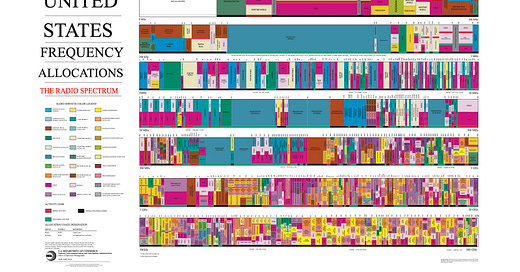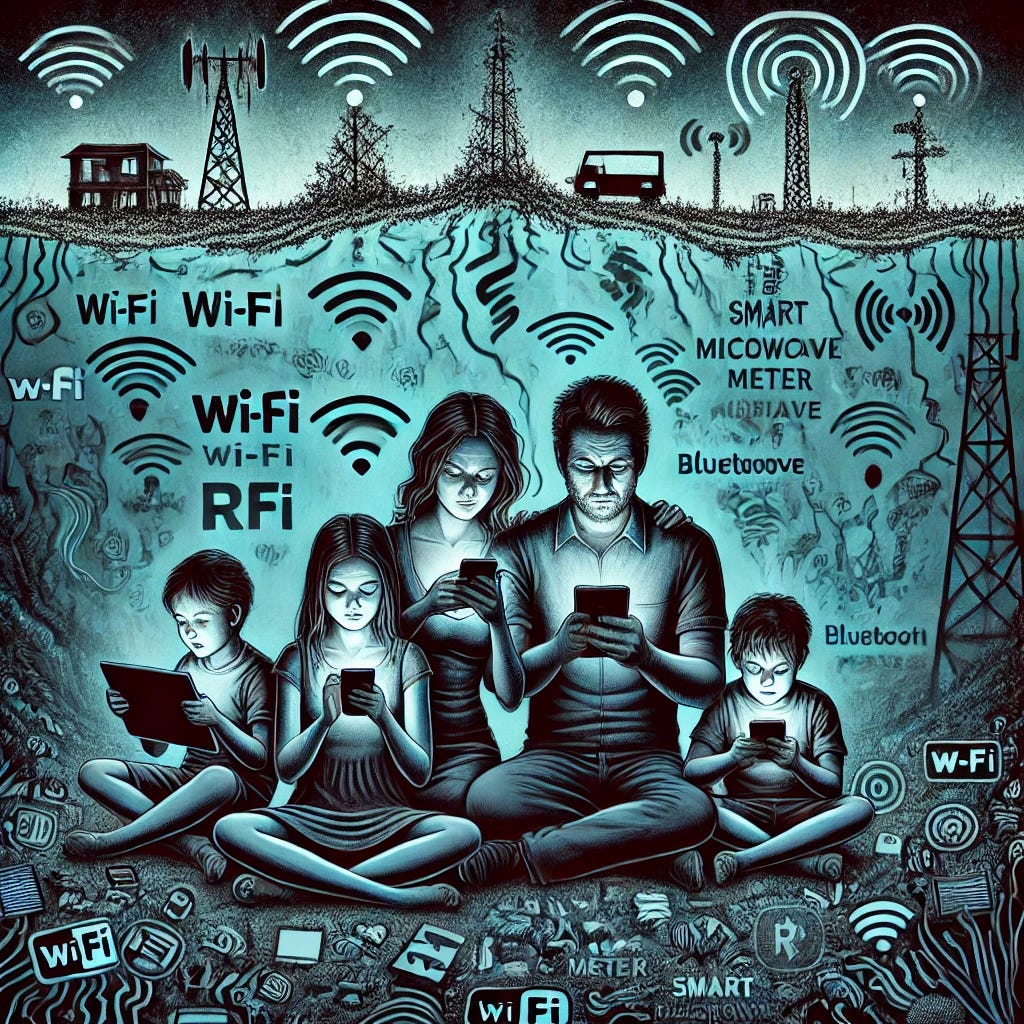The above chart clearly illustrates the problem. Unaccountable entities have 'devoted to destruction' the natural electromagnetic spectrum, which supports life on Earth by allocating each part of the spectrum to conversion into synthetic radiation.
In part one, we began comparing the native and nurturing electromagnetic environment on Earth to the synthetic and harmful EMFs, focusing on the 'low-frequency' phenomenon. In my extensive discussions with individuals who have experienced life-altering synthetic EMF sensitization, most report that sensitization coincided with increased radio frequency (RF) radiation exposure in their environment. While not always the culprit, RF radiation is most often implicated. RF radiation has no analog; there is nothing in the natural world to compare.
RF radiation has never been proven harmless, yet it has become the foundation of many 'services' in the 21st century and personal 'smart' devices. Disturbingly, it also cooks food and destroys military targets. RF radiation is the 800-pound gorilla in synthetic EMFs — it can't be ignored.
We're still in our infancy in understanding the full extent of EMF harm. We must recognize the factors we've already discussed in part one; each plays a critical role in the overall impact of synthetic EMFs. My best results come from addressing all synthetic EMF phenomena. By building a solid foundation for understanding synthetic EMF, we can progress to assessment and remediation techniques.
Continuing our desire to 'know our enemy,' let's examine the critical phenomenon of RF radiation, which stands out due to its unnatural characteristics, including polarization, intensity, modulation, spectrum range, and coherence.
Polarization: Intentionally radiated RF radiation is polarized, meaning their vibrations can be aligned in specific orientations, including vertical, horizontal, and circular. This control of orientation is unseen in natural electromagnetic fields, which exhibit random or less orderly orientations. Polarized RF radiation may penetrate living organisms in ways that natural electromagnetic fields do not.
Intensity: RF radiation is significantly more intense at its source than the natural intercellular communication signals within biological systems, often by many orders of magnitude. This unnatural intensity creates an enormous gradient of synthetic radiation that diminishes with distance but remains impactful over potentially very large areas. The higher the intensity at the source, the greater the potential for biological effects over a larger area, even as the radiation decreases in intensity away from the source, approaching but never reaching zero intensity.
Moreover, it's crucial to recognize that the RF radiation impacting your environment and health may not solely originate from your devices. It could be your neighbor's smartphone or Wi-Fi router causing the most biologically significant exposure to your family and vice-versa.
Modulation: RF radiation often uses modulation, for example where a lower frequency signal is superimposed on a higher frequency carrier wave. This type of modulation doesn't exist in nature. Pulse-modulated RF radiation, a specific modulation type, seems particularly disruptive to biological systems. Unlike continuous natural EMFs, pulse-modulated synthetic EMFs generate bursts of energy that perhaps optimally interferes with cellular processes and bioelectromagnetic functions. Clients regularly report increased sensitivity and health issues with exposure to pulse-modulated RF radiation.
Spectrum Range: Natural emissions from the sun, for example, are broad-band, spanning all ranges of ultraviolet, all colors of the visible spectrum, and all ranges of infrared. This broad spectrum supports various biological functions and is an integral part of our environment. In contrast, synthetic RF radiation often utilizes narrow-band frequencies.
Coherence: RF radiation maintains a consistent phase relationship over a distance. This consistent synchronization is unlike natural emissions, which are more random and less organized.
Interaction and Interference
Today's average home environment is filled with an unnatural sea of RF radiation. If this were not so, your smart tech would not operate—no sea of unnatural radiation means no 'service'. The home is thus optimized not for life and health but for tech—a complex landscape of RF radiation from various internal and external sources interacting in intricate ways.
Internally, Wi-Fi routers, smartphones, smart meters, microwave ovens, and Bluetooth devices emit continuous and often overlapping RF signals. Externally, RF emissions from cell towers and neighboring Wi-Fi networks easily penetrate the home, adding to the sea of unnatural radiation. These external sources interact with the internal ones, creating a dense and dynamic RF environment. The walls of the home also play a significant role in this interaction. They can partially block and reflect RF signals, leading to high and low intensity areas, known as dead zones and hot spots.
Reflection and diffraction can cause signals to overlap unpredictably, sometimes creating frequencies not present in the sources. This complex interplay of internal and external RF sources, along with their interaction with physical barriers within the home, creates a highly unnatural environment—where your head might be immersed in radiation while your toes remain at peace, only to experience the opposite just a moment later as you move from place to place, or activity to activity.
Conclusion
RF emissions in our environment are fundamentally unnatural. Unlike legitimate electromagnetic fields, these synthetic RF signals are omnipresent, filling our homes from internal and external sources, including our neighbors' devices. This intrusion highlights the involuntary nature of our exposure, a critical concern for anyone wishing to avoid synthetic EMF.
Artificial allocations must not override the natural spectrum, yet captured agencies have allowed this without public consent. This makes RF radiation the 800-pound gorilla in the realm of EMF concerns. Addressing it is essential in home assessment and remediation efforts. Choosing appropriate instruments for accurate measurement is crucial to understanding the true extent of exposure.
A sea of unnatural radiation supports digital, not analog life. While RF radiation is a significant concern, it is not the only one, and comprehensive assessment and remediation must consider all forms of synthetic EMFs to create healthier living environments.







If I may, I'd like to ask that we keep comments on-topic with EMF assessment, remediation and surviving electromagnetic poisoning. Thanks!
I am not clear on EMF from surrounding wifi, coming from other apartments as well as homes around me, versus dirty electricity issues. With the electricity, is that electromagnetic and does remediation mean moving it from high frequency on the meter to low frequency? Also, is that high gauss versus low gauss? Or is that something different?